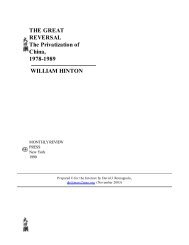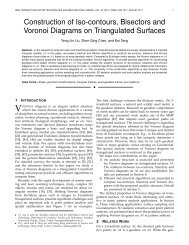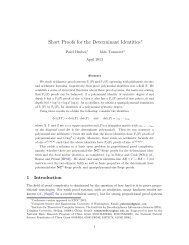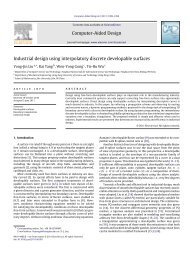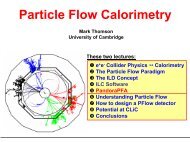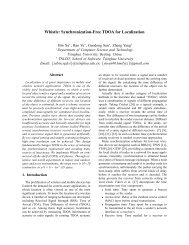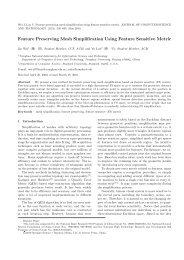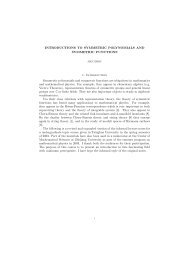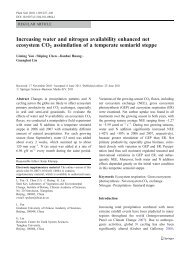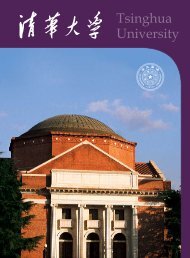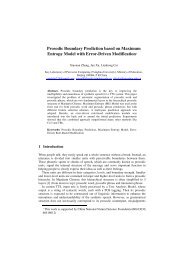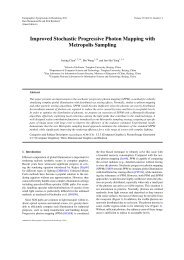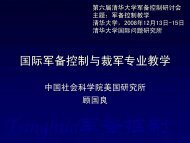Resonant tunneling through the repulsive Coulomb barrier of a ...
Resonant tunneling through the repulsive Coulomb barrier of a ...
Resonant tunneling through the repulsive Coulomb barrier of a ...
- No tags were found...
Create successful ePaper yourself
Turn your PDF publications into a flip-book with our unique Google optimized e-Paper software.
BRIEF REPORTS PHYSICAL REVIEW A 85, 064503 (2012)resonant <strong>tunneling</strong> state—as prepared by <strong>the</strong> absorption <strong>of</strong> onepump photon. The inset in Fig. 4(a) displays more details <strong>of</strong><strong>the</strong> pump-probe transient signal and <strong>the</strong> associated dynamics.With increasing pump-probe delay, <strong>the</strong> transient signal rapidlydecays as population is lost from <strong>the</strong> 3.2-eV <strong>tunneling</strong> state.No transient signal is observed for pump-probe delays beyond4.48 ps. Figure 4(b) shows <strong>the</strong> integrated transient signalintensity versus <strong>the</strong> pump-probe delay. This intensity curvewas fitted with a single exponential decay to obtain <strong>the</strong>effective lifetime <strong>of</strong> <strong>the</strong> <strong>tunneling</strong> state by also taking intoaccount <strong>the</strong> experimental time resolution. This yields a timeconstant <strong>of</strong> 450 ± 90 fs, which is comparable to <strong>the</strong> timeresolution <strong>of</strong> <strong>the</strong> experiment. We note that this lifetime isconsistent with <strong>the</strong> inference from <strong>the</strong> angular distributions,which show that <strong>tunneling</strong> emission from <strong>the</strong> 3.2-eV excitedstate is complete within a molecular rotational period. It is alsoconsistent with (but somewhat above) <strong>the</strong> lifetime estimatedfrom WKB <strong>the</strong>ory using <strong>the</strong> model RCB.In conclusion, resonant <strong>tunneling</strong> <strong>through</strong> <strong>the</strong> <strong>repulsive</strong><strong>Coulomb</strong> <strong>barrier</strong> <strong>of</strong> a quadruply charged anion has been explored.The energetics and dynamics <strong>of</strong> <strong>the</strong> resonant state wereinvestigated using one-photon photoelectron spectroscopyand imaging, <strong>the</strong>oretical calculations, and two-color, timeresolvedpump-probe photoelectron spectroscopy. <strong>Resonant</strong>states within <strong>the</strong> RCB may be quite common in complexMCAs. Investigation <strong>of</strong> <strong>the</strong> resonant <strong>tunneling</strong> via RCBmay open up new opportunities for investigating <strong>the</strong> uniqueproperties <strong>of</strong> multiply charged anions and electron emissiondynamics in complex systems.FIG. 4. (Color online) (a) Pump-probe photoelectron spectra <strong>of</strong>BDSZ 4− at <strong>the</strong> indicated delay times. The inset displays an expandedscale (15 × ) <strong>of</strong> <strong>the</strong> transient signal corresponding to photodetachmentfrom <strong>the</strong> <strong>tunneling</strong> state. (b) (Blue circles) integrated photoelectronsignals from <strong>the</strong> 4.6–5.7 eV transient region vs <strong>the</strong> pump-probe delay;(red line) a single exponential fit; (black dashed line) time resolutionfrom laser cross-correlation measurement (both in arbitrary units).process. Here interaction with a 775-nm probe photon leadsto photodetachment <strong>of</strong> electrons from <strong>the</strong> 3.2-eV transientACKNOWLEDGMENTSThe experiments done at Brown were supported by <strong>the</strong>National Science Foundation (Grant No. CHE-1049717 toL.S.W.). The experiments done at KIT were supported by <strong>the</strong>Deutsche Forschungsgemeinschaft (CFN C3.2 to M.M.K.).M.Y.R. and N.C.G. would like to acknowledge <strong>the</strong> NationalNatural Science Foundation <strong>of</strong> China for partial support <strong>of</strong> thiswork (Grant No. 11174175).[1] J. Simons, J. Phys. Chem. A 112, 6401 (2008).[2] S. N. Schauer, P. Williams, and R. N. Compton, Phys. Rev. Lett.65, 625 (1990).[3] J. Kalcher and A. F. Sax, Chem. Rev. 94, 2291 (1994).[4] M. K. Scheller, R. N. Compton, and L. S. Cederbaum, Science270, 1160 (1995).[5] A. I. Boldyrev, M. Gutowski, and J. Simons, Acc. Chem. Res.29, 497 (1996).[6] G. R. Freeman and N. H. March, J. Phys. Chem. 100, 4331(1996).[7] L. S. Wang and X. B. Wang, J. Phys. Chem. A 104, 1978(2000).[8] A. Dreuw and L. S. Cederbaum, Chem. Rev. 102, 181 (2002).[9] X. B. Wang and L. S. Wang, Nature 400, 245 (1999).[10] S. Tomita et al., J. Chem. Phys. 124, 024310 (2006).[11] K. Arnold, T. S. Balaban, M. N. Blom, O. T. Ehrler, S. Gilb,O. Hampe, J. E. v. Lier, J. M. Weber, and M. M. Kappes,J. Phys. Chem. A 107, 794 (2003).[12] X. B. Wang, A. P. Sergeeva, X. P. Xing, M. Massaout,T. Karpuschkin, O. Hampe, A. I. Boldyrev, M. M. Kappes, andL. S. Wang, J. Am. Chem. Soc. 131, 9836 (2009).[13] R. N. Compton, A. A. Tuinman, C. E. Klots, M. R. Pederson,andD.C.Patton,Phys. Rev. Lett. 78, 4367 (1997).[14] X. B. Wang, C. F. Ding, and L. S. Wang, Chem. Phys. Lett. 307,391 (1999).[15] M. N. Blom, O. Hampe, S. Gilb, P. Weis, and M. M. Kappe, J.Chem. Phys. 115, 3690 (2001).[16] S. Panja et al., J. Chem. Phys. 127, 124301 (2007).[17] L. S. Wang, C. F. Ding, X. B. Wang, and S. E. Barlow, Rev. Sci.Instrum. 70, 1957 (1999).[18] L. S. Wang, C. F. Ding, X. B. Wang, and J. B. Nicholas, Phys.Rev. Lett. 81, 2667 (1998).[19] X. B. Wang, K. Ferris, and L. S. Wang, J. Phys. Chem. A 104,25 (2000).[20] O. T. Ehrler, J. P. Yang, A. B. Sugiharto, A. N. Unterreiner, andM. M. Kappes, J. Chem. Phys. 127, 184301 (2007).064503-4



